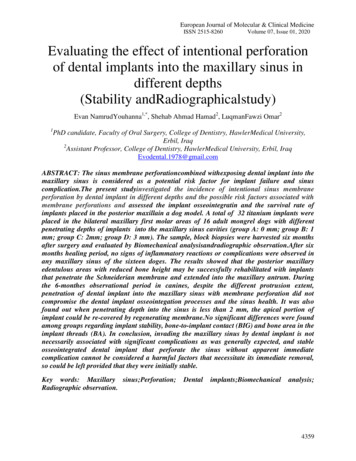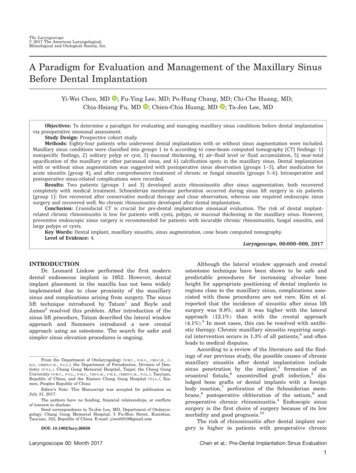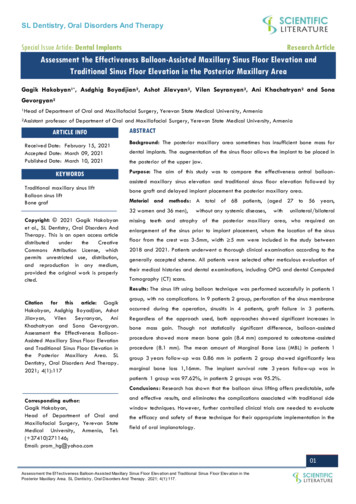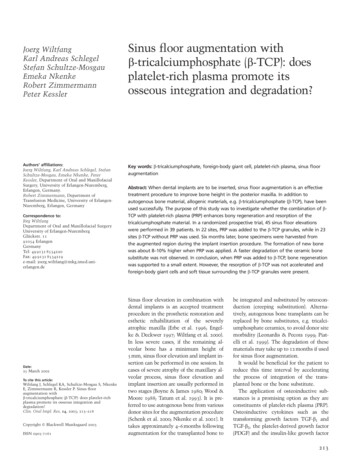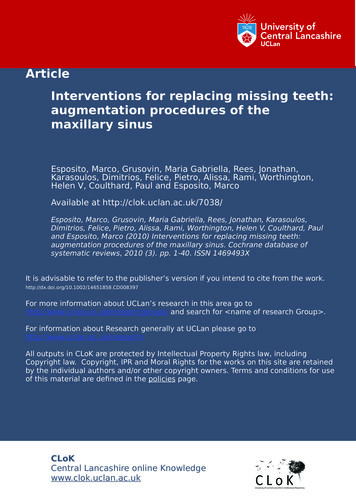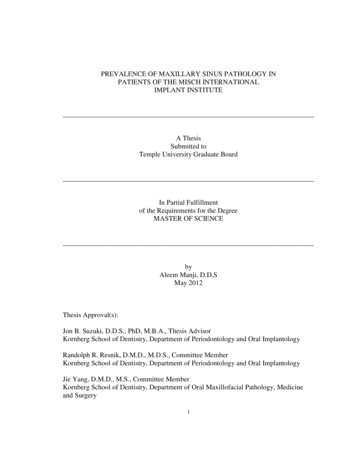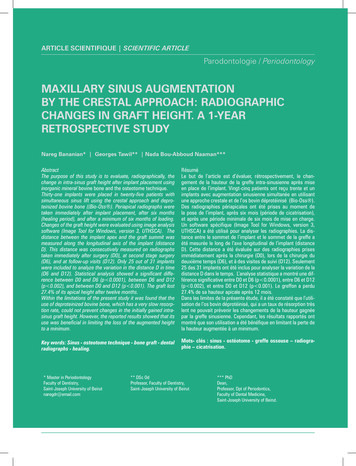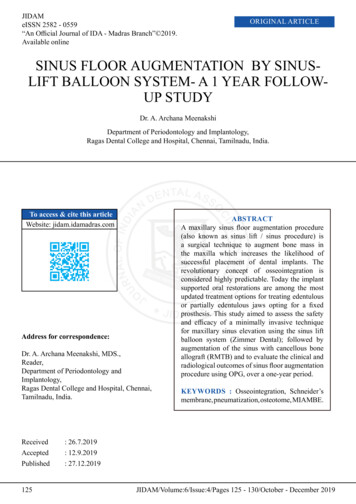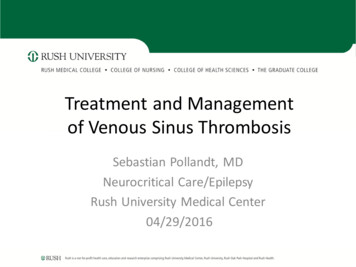
Transcription
Localized Management of Sinus Floor WithSimultaneous Implant Placement: A Clinical ReportGiovanni B. Bruschi, MD, DDS*/Agostino Scipioni, MD, DDS*/Gaetano Calesini, MD, DDS*/Ernesto Bruschi, DDS*Localized management of sinus floor (LMSF) achieves implant placement and sinus lifting simultaneously. LMSFis a further application of the principles of the edentulous ridge expansion (ERE) technique. It comprises the dissection of a partial-thickness flap, the buccal expansion of the residual alveolar bone, and the fracture and elevation of the sinus floor with simultaneous implant placement. Three hundred three patients were treated with 499implants placed using the LMSF between April 1988 and December 1993. The selected patients, who showed nosigns of sinus pathology, exhibited insufficient vertical alveolar bone dimensions for the placement of dentalimplants with the traditional technique. The minimal residual alveolar bone height was between 5 and 7 mm.Based on the criteria established by Albrektsson and his coworkers in 1986, the success rate of the 499 implantsplaced with the LMSF was 97.5%.(INT J ORAL MAXILLOFAC IMPLANTS 1998;13:219–226)Key words: edentulous ridge expansion, osseointegration, sinus elevationOsseointegrated dental implant therapy initiallywas indicated only for completely edentulouspatients,1,2 but more recently it has also been used inpartially edentulous patients.3–6 Treatment of completely and partially edentulous patients with osseointegrated implants differs significantly: in completelyedentulous patients, implants placed only in the anterior segments of the mandibular and maxillary archescan provide sufficient support for either a removableor a fixed prosthesis; however, in partially edentulouspatients, clinicians frequently are confronted withanatomic variations of the premolar and molar areas,one of which is the maxillary sinus. Periodontal diseases frequently cause the loss of maxillary molarswith local resorption of the alveolar bone; and inpatients with a large maxillary sinus, bone dimensionsoften are inadequate for the placement of properlyproportioned implants.It is also important to consider the magnitude ofocclusal forces in the posterior segments of the den-*Private Practice, Rome, Italy.Reprint requests: Dr Giovanni B. Bruschi, Via di Porta Pinciana4, 00187 Rome, Italy. E-mail: bsc@exhibit.itC OPYRIGHT 2000BYQ UINTESSENCE PUBLISHING C O ,IN C.PRINTINGOFTHIS DOCUMENT IS RESTRICTED T O PERSONAL USE ONLY. NO PART OF THISARTICLE M A Y BE REPRODUCED O R TRANSMITTED IN A N Y FORM WITHOUTWRITTEN PERMISSION FROM THE PUBLISHER.tal arch in relation to implant support. Molars aremultirooted teeth with large occlusal surfaces and ananatomy that is specifically designed for masticatoryfunction. In a well-designed treatment plan, if theseteeth have to be replaced with osseointegratedimplant-supported prostheses, the clinician mustconsider the possibility or necessity of replacing theteeth with relatively large implants.The successful placement of implants in the posterior maxillary arch of partially edentulous patients isadvantageous clinically because it is the ideal way toresolve the prosthetic problems related to this type ofcondition. This is especially true for dental arches withclass I and II of the Applegate-Kennedy classificationin patients who wear removable partial prostheses.A variety of bone augmentation procedures havebeen used to create sufficient bone support for properly proportioned osseointegrated implants in theposterior segments of the maxillary arch. One ofthese is the “sinus lift” procedure, consisting of localized bone grafting on the alveolar ridge.7–9 Kahnberget al8 reported bone graft exposure, and the resultingloss of a graft portion, during the healing phase in30% of the patients treated with this technique. Inaddition, it has been reported that 8 to 14% of theimplants are lost prior to loading and 26% are lostThe International Journal of Oral & Maxillofacial Implants219
Bruschi et alduring the first 5 years.8,9 Boyne and James10 andBrånemark et al11 reported the formation of bonearound the apical portion of implants placed by carefully raising the Schneiderian membrane, providedthe occlusal portion of the implant has integratedwith crestal bone. Nonetheless, the failure rateremains around 70% during the first 5 to 10 years ofprosthetic loading. Tatum12 proposed a modificationof the Caldwell-Luc procedure, which involved along healing time. Misch 13 suggested combiningimplant placement and sinus lift in a single surgicalprocedure. Sindet-Pedersen and Enemark 14 proposed the use of intramembranous bone as graftmaterial. Hirsch & Ericsson15 reported the use ofmandibular bone grafts.Localized management of the sinus floor (LMSF)is a reliable solution to the problems describedabove. In a single surgery, the procedure combineselevation of the maxillary sinus floor, buccal expansion of the residual alveolar bone, and implant placement. As in the edentulous ridge expansion (ERE)technique,16–18 bone regeneration and implant osseointegration occur simultaneously.The basis for the LMSF approach is the carefulfracture of the sinus floor cortex, which inducesadvantageous peri-implant osteogenesis. Moreover, aspreviously mentioned, the LMSF involves simultaneous horizontal bone regeneration according to theprinciples of the ERE technique. Both the LMSF andthe ERE techniques can usually be performed in asingle surgical stage. Compared to multiple-stage procedures, healing times are, of course, much reduced.The LMSF allows osseointegration of implantsthat far exceed the preoperative bone dimensions inlength and caliber. Moreover, as in the ERE technique, buccal bone regeneration in LMSF facilitatesthe achievement of an optimal implant position withrespect to occlusal forces.Materials and MethodsUsing LMSF, 499 implants (317 IMZ and 182 Frialit2; Friatec AG, Mannheim, Germany) were placed in303 patients between April 1988 and December1993. Based on periapical radiographs produced withthe paralleling technique and/or computed tomography (CT) scans, the minimal residual alveolar boneheight was judged to be between 5 and 7 mm. All499 implants included in this work were placed usingthe LMSF protocol in edentulous areas of the posterior maxillary arch that were not suitable for traditional implant surgery without some form of boneaugmentation procedure because of the proximity ofthe sinus floor. All patients included in this studywere edentulous in one or both maxillary posteriorsegments (Applegate-Kennedy classes I, II, and III).Patients were informed of the possibility of a higherthan-normal risk of failure before submitting writtenconsent to proceed. All patients received annual radiographic evaluations according to the protocolsestablished by Albrektsson et al.19Preoperative Evaluation. Various authors havesuggested that deep periodontal pockets may act as areservoir for bacteria that may infect implantsites. 20–22 Accordingly, any periodontal infectionswere resolved before the initiation of implant surgery.All signs and symptoms of sinus inflammation orinfection also were resolved prior to implant surgery.Surgical Protocol. Local Xylocaine anesthesia(Astra, Milan, Italy) was used on all patients. All werepremedicated with a nonsteroidal anti-inflammatorydrug (Naprosyn, 1.5 g; Recordati, Milan, Italy) andan antimicrobial agent (Ciproxin, 1 g; Bayer, Milan,Italy) 1 hour before surgery. Antibacterial and antiinflammatory medication were continued for 3 to 4days after surgery.The surgical procedure of LMSF is an advancedapplication of the previously reported ERE technique.16–18 The distance between the ridge crest andthe floor of the sinus is measured on a periapicalradiograph produced with the paralleling technique(Fig 1). The implant site is exposed via a modifiedsuperimposed23 partial-thickness flap. The first incision starts on the palatal surface of the masticatorymucosa with a long bevel that extends buccally withinthe suprabony connective tissue and continues overthe edentulous crest and towards the fornix. The second incision is complementary to the first; it beginson the buccal border of the bevel and continueswithin the connective tissue on the palatal aspect ofthe ridge (Fig 2).A vertical fissure is opened within and through theresidual alveolar bone with a No. 64 Beaver blade(Becton Dickinson Acute Care, Franklin Lakes, NJ)(Fig 3). The incision is drawn along the crest of theridge (covered by preserved suprabony soft tissue,including the periosteum and its vasculature),through cortex and spongiosa, and towards the floorof the maxillary antrum.The buccal wall of the intra-alveolar fissure (consisting of the preserved suprabony connective tissueand compact and cancellous bone—ie, a sort of“bone flap”—for a minimum overall thickness of 1.0to 1.5 mm) is carefully displaced buccally, whilesimultaneously the intrabony fissure is deepened towithin 0.5 to 1.0 mm of the sinus floor. The crestaldistraction corresponds to a small rotation around thebasal bone. The result is creation of a new spacewithin the cancellous bone of the residual alveolarcrest (Fig 4).C OPYRIGHT 2000220 Volume 13, Number 2, 1998BYQ UINTESSENCE PUBLISHING C O ,IN C.PRINTINGOFTHIS DOCUMENT IS RESTRICTED T O PERSONAL USE ONLY. NO PART OF THISARTICLE M A Y BE REPRODUCED O R TRANSMITTED IN A N Y FORM WITHOUTWRITTEN PERMISSION FROM THE PUBLISHER.
Bruschi et alFig 1 Case A. The distance between the ridge crest and thefloor of the sinus is measured on a preoperative periapical radiograph produced with the paralleling technique. For thispatient, the treatment plan prescribes the placement of animplant in the position of the first molar. Four months later, thethird molar will be extracted and the second molar uprighted.Fig 2 Illustration depicting the exposure of the implant sitewith a modified superimposed partial-thickness flap. The firstincision starts on the palatal surface of the masticatory mucosawith a long bevel that extends buccally within the suprabonyconnective tissue and continues over the edentulous crest andtowards the fornix. The second incision begins on the buccalborder of the bevel and continues within the connective tissueon the palatal aspect of the ridge.Fig 3 An intrabony fissure is carved within the bone crest witha No. 64 Beaver blade, and it is deepened almost to the level ofthe maxillary sinus floor.Fig 4 A Heidbrink root elevator (Hu-Friedy, Chicago, IL) isused to enlarge the intrabony fissure. The careful rotation of theelevator’s tip within the bone groove obtains the initial horizontal expansion of the crest by displacing the buccal wall of theintrabony fissure, which is simultaneously deepened to within0.5 to 1.0 mm of the sinus floor.Up to this stage, the LMSF corresponds to theERE technique, since a new horizontal intrabonyspace (buccal ridge expansion) is created but doesnot disturb the sinus floor. The implant bed is created with a series of round end probes, with diameters of 2.5, 3.3, and 4.0 mm. Surgical burs areavoided because they are too destructive for the delicate bone involved. The 2.5-mm probe is gentlytapped with a surgical mallet to compress theremaining 1.0 to 0.5 mm of bone against the cortex ofthe maxillary antrum. This procedure continues withthe 3.3- and 4.0-mm probes. The force applied mustalways be proportioned to the bone’s resistance. Theforce used then increases progressively until an initialfracture of the sinus floor, with minimal or no displacement, is obtained (Fig 5). Very delicate, carefultapping is now used to displace the complex ofSchneiderian membrane and cortical and pericorticalosseous tissue into the sinus cavity. These structuresare considered potential sources of osteogeneticcells, and consequently their integrity must be preserved while they are displaced.C OPYRIGHT 2000BYQ UINTESSENCE PUBLISHING C O ,IN C.PRINTINGOFTHIS DOCUMENT IS RESTRICTED T O PERSONAL USE ONLY. NO PART OF THISARTICLE M A Y BE REPRODUCED O R TRANSMITTED IN A N Y FORM WITHOUTWRITTEN PERMISSION FROM THE PUBLISHER.The International Journal of Oral & Maxillofacial Implants221
Bruschi et alFig 5 The implant bed is created with a series of round endprobes, with diameters of 2.5, 3.3, and 4.0 mm. The 2.5-mmprobe is gently tapped with a surgical mallet to compress theremaining 0.5 to 1.0 mm of bone against the cortex of the maxillary antrum. This procedure continues with the 3.3- and 4.0mm probes, and the force used increases progressively until aninitial fracture of the sinus floor, with minimal or no displacement, is obtained.Fig 7 Case A. Postoperative periapical radiograph producedwith the paralleling technique immediately after the placementof a 10 5.5 mm Frialit-2 implant with LMSF. The shadow ofthe fractured sinus floor can be seen above the implant.Once the space obtained with the probes is sufficient for the planned implant(s), a 1 1 cm collagensheet is placed in the implant bed and pushed againstthe vault. The implant is then tapped into position(Figs 6 and 7).In addition to having limited crestal height, mostpatients also exhibited inadequate palatobuccaldimensions of the crestal bone (Figs 8 and 9) andthus required horizontal expansion to accommodatethe proposed implants (Figs 10 and 11). Primary stability was not a problem. The bone plates and theirFig 6 The planned implant is tapped into position in the spaceobtained with the probes. The red substance around the basalportion of the implant represents a collagen sheet.covering soft tissues retained elasticity, and thereforeclosed back on the implant(s), locking them into position. Screw-shaped implants placed with this technique must be tapped into position.The net result is the creation of new horizontaland vertical intraosseous spaces for the implants,with complete preservation of the original bone. Thehorizontal expansion corresponds, as indicated above,to the buccal displacement of the vestibular corticalplate, which has already been proved successful inthe ERE technique.17,18 The combination of the horizontal and vertical augmentation of the implant bed,the distinctive characteristic of LMSF, is thus owedto the sinus cavity, within which the complex of cancellous and cortical bone, periosteum, and respiratory mucosa lining is displaced.Postoperative Treatment. Ciproxin (1 g/day)and Naprosyn (1.5 g/day) were continued postoperatively for 3 to 4 days. Sutures were removed after 1week. Removable prostheses were always adaptedpostoperatively to the enlarged ridge morphology byremoving the vestibular portion of the acrylic resin,but patients were also discouraged from using themfor the first 1 to 2 weeks. After this initial period, thetissue-bearing surfaces were rebased with a soft lining material, avoiding any pressure in the emergingimplant zone(s). Stage-two surgery was invariablyperformed 4 months after implant placement. Aheat-cured acrylic resin temporary prosthesis wasthen fabricated and worn for at least 3 to 5 months.All patients were followed with annual radiographicevaluations (Figs 12 and 13).C OPYRIGHT 2000222 Volume 13, Number 2, 1998BYQ UINTESSENCE PUBLISHING C O ,IN C.PRINTINGOFTHIS DOCUMENT IS RESTRICTED T O PERSONAL USE ONLY. NO PART OF THISARTICLE M A Y BE REPRODUCED O R TRANSMITTED IN A N Y FORM WITHOUTWRITTEN PERMISSION FROM THE PUBLISHER.
Bruschi et alC OPYRIGHT 2000BYFig 8 Case B. Clinical photographshowing the appearance of the edentulous ridge of the right maxilla beforesurgery.Fig 9 Case B. Exposure of the crest withthe modified superimposed partial-thickness flap. Note generalized buccolingualresorption of the crest and marked concave defect distal to the canine.Fig 10 Case B. The implants as theyappear immediately after placement withLMSF. The displacement of the “boneflap,” which is kept open by the implants, results in immediate horizontalexpansion of the crest and simultaneouscorrection of the concave defect distal tothe canine.Fig 11 Case B. Clinical photograph ofthe crest 10 months after placement ofthe implants with LMSF. Compared to Fig8, the magnitude of horizontal ridgeexpansion obtained is visible.Q UINTESSENCE PUBLISHING C O ,IN C.PRINTINGOFTHIS DOCUMENT IS RESTRICTED T O PERSONAL USE ONLY. NO PART OF THISARTICLE M A Y BE REPRODUCED O R TRANSMITTED IN A N Y FORM WITHOUTWRITTEN PERMISSION FROM THE PUBLISHER.The International Journal of Oral & Maxillofacial Implants223
Bruschi et alFig 12 Case A. Periapical radiograph produced with the paralleling technique at the time of stage-two surgery, performed asusual 4 months later. The modified profile or the cortical bonelining the floor of the maxillary sinus can be identified abovethe implant. The transformation is evident when this radiographis compared with Fig 1, using the apex of the second bicuspidas a reference point.Fig 13 Case A. Two-year follow-up radiograph. The uprightingof the second molar was accomplished over a period of 50 daysby increasing weekly the intensity of the distal contact point onan acrylic resin temporary crown supported by the implant.Table 1a Annual Numbers of Patients Treated and Failures Recorded for the IMZ Implants Placed With LMSFBetween 1988 and 1993Table 1b Sex and Age Distribution of Patients TreatedWith IMZ Implants Placed With LMSF Between 1988and 1993YearNo. ofimplantsNo. ofpatientsNo. offailed 564520000132Total3171996Table 2a Annual Numbers of Patients Treated and Failures Recorded for the Frialit-2 Implants Placed WithLMSF Between 1992 and 1993YearNo. ofimplantsNo. ofpatientsNo. offailed implants1992199352130327242Total1821046ResultsThe results are summarized in Tables 1a and 1b forIMZ implants and in Tables 2a and 2b for Frialit-2implants. The standard of success for implant function established by Albrektsson et al19 was applied.SexPercentMean age (y)FemaleMale69.330.75248Table 2b Sex and Age Distribution of Patients TreatedWith Frialit-2 Implants Placed With LMSF Between 1992and 1993SexPercentMean age (y)FemaleMale65.334.74952Overall, in the period considered, 303 patientsreceived 499 implants. The success rate was 97.5%.The most recent implants included in this reportwere functionally loaded for more than 24 months.The earliest implants were loaded for at least 5years.C OPYRIGHT 2000224 Volume 13, Number 2, 1998BYQ UINTESSENCE PUBLISHING C O ,IN C.PRINTINGOFTHIS DOCUMENT IS RESTRICTED T O PERSONAL USE ONLY. NO PART OF THISARTICLE M A Y BE REPRODUCED O R TRANSMITTED IN A N Y FORM WITHOUTWRITTEN PERMISSION FROM THE PUBLISHER.
Bruschi et alDiscussionThe failure in 1991 occurred in a patient whoreceived a total of three implants and lost all of them.One was placed using the LMSF technique and istherefore included in the data of this report; theother two were placed using a traditional procedure.The adequately supported implants failed along withthe one placed using LMSF, suggesting the possiblepresence of an underlying organic condition thatinterfered with the healing process.It is interesting to note that the three failuresrecorded in 1992 also occurred in a single patient.This patient wore a maxillary removable prosthesisthat was anchored with clasps to the surviving teeth.Thus, it was difficult to control the pressure on theunderlying implants. Although they were consideredfailures in this study, these implants were replaced(after modifying the prosthesis) with two newimplants, which are now functioning well.Many other techniques have been proposed toresolve the lack of adequate bone support for implantsin the maxillary posterior area. However, all of theseare invasive, disrupt the normal anatomic relationshipsof the structures of this area, rely on the placement offoreign substances into the sinus cavity, and sometimes involve membrane-guided healing (which maypromote complications during the healing phase).The LMSF procedure, when properly performed,uses only natural healing potential, is simple, and, inpractice, well tolerated. Four patients experiencedminor nasal bleeding, which disappeared within thefirst 24 to 48 hours. This was the only postoperativecomplication experienced.Primary stability is achieved when implants aretapped into place, because the maxillary cortical andcancellous bone, covered by the preserved periosseous connective tissues, is elastic and closes backon the implants to become tightly adapted to theirsurfaces.Radiographic analysis of the successful implantsshowed that an increase of 3 to 7 mm of availablebone is possible with this procedure.ConclusionsWith the LMSF, it is possible to expand the dimensions of resorbed posterior maxillary alveolar boneboth vertically and horizontally. In addition, theLMSF offers reliable (97.5% success) implantosseointegration within the expanded bone plates.Moreover, the implant can be large enough toreplace the lost maxillary molars and is thereforecapable of sustaining the heavy occlusal forces characteristic of this area.C OPYRIGHT 2000BYQ UINTESSENCE PUBLISHING C O ,IN C.PRINTINGWRITTEN PERMISSION FROM THE PUBLISHER.AcknowledgmentsThe authors wish to acknowledge the editorial assistance of DrDavid R. Leidner at various stages in the preparation of this manuscript.References01. Adell R, Lekholm U, Rockler B, Brånemark P-I. A 15-yearstudy of osseointegrated implants in the treatment of theedentulous jaw. J Oral Surg 1981;10:387–416.02. Adell R, Eriksson B, Lekholm U, Brånemark P-I, Jemt T. Along-term follow-up study of osseointegrated implants in thetreatment of the totally edentulous jaw. Int J Oral MaxillofacImplants 1990;5:347–359.03. Ericsson I, Lekholm U, Brånemark P-I, Lindhe J, Glantz P-O,Nyman S. A clinical evaluation of fixed bridge restorationssupported by the combination of teeth and osseointegratedtitanium implants. J Clin Periodontol 1986;13:307–312.04. Ericsson I, Glantz P-O, Brånemark P-I. Use of implants inrestorative therapy in patients with reduced periodontal tissuesupport. Quintessence Int 1988;19:801–807.05. Jemt T, Lekholm U, Adell R. Osseointegrated implants in thetreatment of partially edentulous patients: A preliminary studyon 876 consecutively placed fixtures. Int J Oral MaxillofacImplants 1989;4:211–217.06. van Steenberghe D, Lekholm U, Bolender C, Folmer T,Henry P, Hermann I, et al. The applicability of osseointegrated implants in the rehabilitation of partial edentulism: Aprospective multicenter study of 558 fixtures. Int J Oral Maxillofac Implants 1992;5:272–281.07. Breine U, Brånemark P-I. Reconstruction of alveolar jawbone. An experimental and clinical study of immediate andpreformed autologous bone grafts in combination withosseointegrated implants. Scand J Plast Reconstr Surg1980;14:23–48.08. Kahnberg KE, Nystrom E, Bardtholdsson L. Combined use ofbone grafts and Brånemark fixtures in the treatment ofseverely resorbed maxillae. Int J Oral Maxillofac Implants1989;4:297–304.09. Adell R, Lekholm U, Gröndahl K, Brånemark P-I, LindströmJ, Jacobsson M. Reconstruction of severely resorbed edentulous maxillae using fixtures in immediate autogenous bonegrafts. Int J Oral Maxillofac Implants 1990;5:233–246.OFTHIS DOCUMENT IS RESTRICTED T O PERSONAL USE ONLY. NO PART OF THISARTICLE M A Y BE REPRODUCED O R TRANSMITTED IN A N Y FORM WITHOUTThe 7-year observation period of 497 implants in302 patients confirms the reliability of the LMSF.Furthermore, when implant failure occurred, as inone patient with peri-implantitis, the regenerated apical bone was preserved even after years of occlusalfunction. With the LMSF, it is possible to adopt theuse of implant therapy for a wider range of edentulous patients. The LMSF permits the placement ofrelatively large implants in sites that are normally considered inappropriate for implant therapy. It allowsthe replacement of maxillary multirooted teeth withappropriately large implants seated in an anatomicallyproper position. In fact, buccal expansion of the alveolar crest also shifts the position of the implant(s)towards a more ideal prosthetic site and improvedocclusal relation. The LMSF combines bone regeneration and osseointegration in a single procedure.The International Journal of Oral & Maxillofacial Implants225
Bruschi et al10. Boyne JP, James RA. Grafting of the maxillary sinus floor withautogenous marrow and bone. J Oral Surg 1980;15:265–281.11. Brånemark P-I, Adell R, Albrektsson T, Lekholm U, Lindström J, Rockler B. An experimental and clinical study ofosseointegrated implants penetrating the nasal cavity andmaxillary sinus. J Oral Maxillofac Surg 1984;42:497–505.12. Tatum H. Maxillary and sinus implant reconstruction. DentClin North Am 1986;30:207–229.13. Misch CE. Maxillary sinus augmentation for endostealimplants: Organized alternative treatment plans. Int J OralImplantol 1987;4:49–58.14. Sindet-Pedersen S, Enemark H. Reconstruction of alveolarclefts with mandibular or iliac bone grafts. J Oral MaxillofacSurg 1990;48:554–558.15. Hirsch JM, Ericsson I. Maxillary sinus augmentation usingmandibular bone grafts and simultaneous installation ofimplants. A surgical technique. Clin Oral Implants Res1991;2:91–96.16. Bruschi GB, Scipioni A. Alveolar augmentation: New applications for implants. In: Heimke G (ed). OsseointegratedImplants, vol 2. Boca Raton: CRC Press, 1990:35–61.17. Scipioni A, Bruschi GB, Calesini G. The edentulous ridgeexpansion technique: A five-year study. Int J Periodont RestDent 1994;14:451–459.18. Scipioni A, Bruschi GB, Giargia M, Berglundh T, Lindhe J.Healing at implants with and without primary bone contact.Clin Oral Implants Res 1997;8:39–47.19. Albrektsson T, Zarb G, Worthington P, Eriksson AR. Thelong-term efficacy of currently used dental implants: A reviewand proposed criteria of success. Int J Oral MaxillofacImplants 1986;1:11–25.20. Apse P, Ellen RP, Overall CM, Zarb CA. Microbiota andcrevicular fluid collagenase activity in the osseointegrateddental implant sulcus: A comparison of sites in edentulous andpartially edentulous patients. J Periodont Res 1989;24:96–105.21. Haanaes HR. Implants and infections with special referenceto oral bacteria. J Clin Periodont 1990;17:516–524.22. Quirinen M, Listgarten MA. The distribution of bacterialmorphotypes around implants ad modum Brånemark. ClinOral Implants Res 1990;1:8–12.23. Langer B, Langer L. The superimposed flap: Modification ofthe surgical technique for implant insertion. Int J PeriodontRest Dent 1990;10:208–215.C OPYRIGHT 2000226 Volume 13, Number 2, 1998BYQ UINTESSENCE PUBLISHING C O ,IN C.PRINTINGOFTHIS DOCUMENT IS RESTRICTED T O PERSONAL USE ONLY. NO PART OF THISARTICLE M A Y BE REPRODUCED O R TRANSMITTED IN A N Y FORM WITHOUTWRITTEN PERMISSION FROM THE PUBLISHER.
sion of the residual alveolar bone, and implant place-ment. As in the edentulous ridge expansion (ERE) technique,16-18 bone regeneration and implant osseo-integration occur simultaneously. The basis for the LMSF approach is the careful fracture of the sinus floor cortex, which induces advantageous peri-implant osteogenesis. Moreover, as

